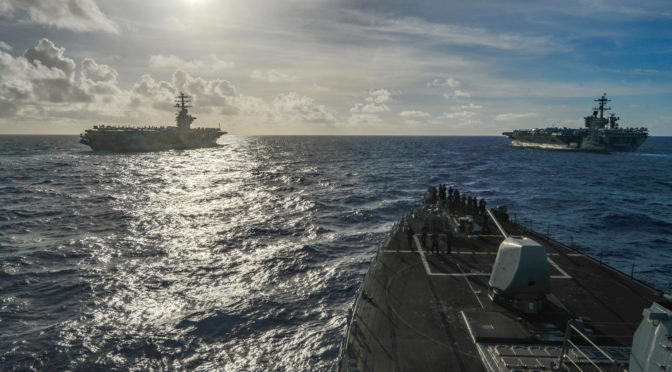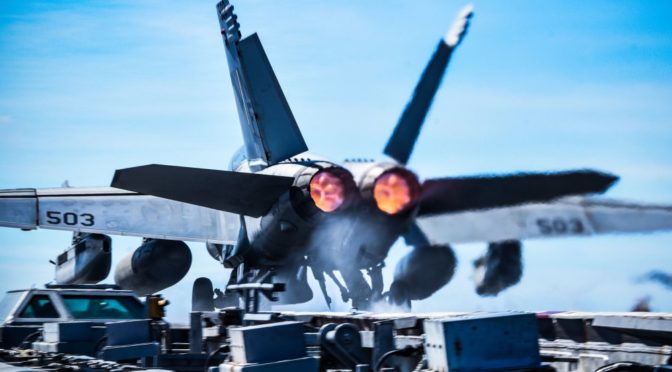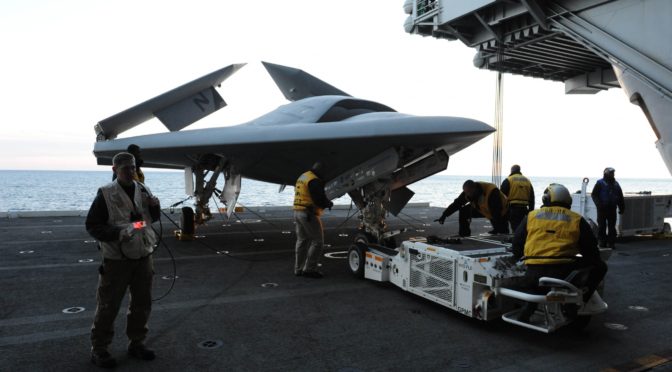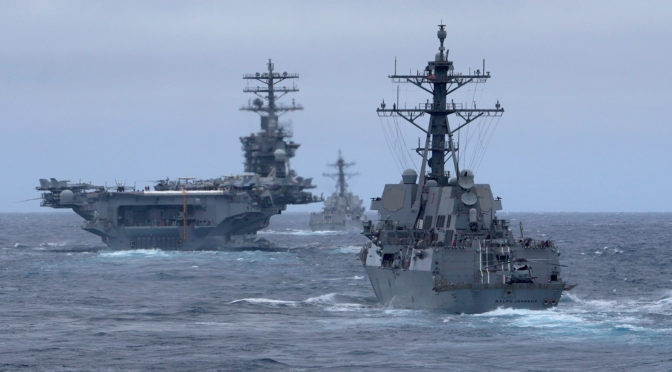Force Structure Perspectives Series
By Dmitry Filipoff
As a part of CIMSEC’s Force Structure Perspectives Series, CIMSEC discussed the Battle Force 2045 fleet design with CDR Phil Pournelle (ret.), who served as a surface warfare officer and in the Office of Secretary of Defense Cost Assessment and Program Evaluation and at the Office of Net Assessment. In this conversation, CDR Pournelle discusses getting away from exquisite legacy platforms, getting fresh perspectives in force structure assessment, and adapting the Navy to the National Defense Strategy.
The Secretary of Defense recently announced a new fleet plan for a future U.S. Navy of 500 ships, a major increase over today’s fleet of around 300 ships. Among many changes, the fleet emphasizes substantial additions in areas such as sealift, unmanned warships, submarines, and smaller surface combatants. What do you make of the size of this fleet and its mix of platforms?
There are two challenges to answering this question: we don’t know what the actual plan is, and we don’t know what the fleet is intended to do. The 30-year shipbuilding plan is overdue to Congress and apparently has been overridden by the Secretary of Defense and others outside the Department of the Navy. Based on the Secretary’s recent public comments it would appear the best guess in the public realm is a report by the Hudson Institute which lays out their own long-term plan and description of how the fleet is intended to operate.
The Hudson report does describe in detail the number and type of platforms to be in the fleet by 2045 based on a modest increase of the Navy’s budget over inflation. This new fleet incorporates a number of new hulls: an optionally manned missile corvette (DDC), an unmanned support vessel (MUSV), an unmanned subsurface vessel (XLUUV), a small amphibious vessel (LAW), and a small Combat Logistic Force Vessel (T-AOL). Unfortunately, the Hudson report provides a very cursory description of these platforms, leaving out details which would be required to provide a proper answer to the question. Therefore any assessment of these vessels must draw upon descriptions of these vessels from other sources and an educated guess regarding the DDC.
Based on all of these assumptions, one would assess that if the Secretary is moving in the direction of the architecture and operational constructs of the Hudson report, then this is a step in the right direction, but there is still plenty of work to be done.
The most important contribution of the Hudson report is the substitution of the ill-conceived Large Unmanned Surface Vessel (LUSV) with the optionally manned (but should be permanently manned) missile corvette (DDC) to provide numbers of potential strike platforms and act as relay missile magazines for the forward forces. When paired with Maritime Sealift Command (MSC) logistics platforms to reload Vertical Launch System (VLS) cells on the DDC close to the scene of action, such platforms will offer a weekly volume of fire which greatly exceeds that of a carrier air wing (CVW) on a per unit cost basis. The DDC and T-AOL combination are nearly the epitome of the concepts of Distributed Lethality and distributed logistics crucial to the survival of a fleet in the modern maritime precision strike regime.
What appears to be lacking is a low cost, low signature, risk-worthy missile boat which can operate in the littoral regions and frustrate our competitor’s reconnaissance strike complex (RUK) and the means to deploy and sustain these platforms. Existing candidates for this mission include the Juliet Marine Ghost Missile Boat (PHM), the Ambassador class fast missile craft (PTM), the M80 Stiletto, and the Naval Postgraduate School Minute Man (PFM). Existing candidates for the role of transport and mothership include the Auxiliary Crane Ship (ACS), the Lighterage Aboard Ship (LASH), the Montford Point class Expeditionary Transfer Dock ship (ESD), and crane operating Offshore Supply Vessels.
This new force structure may be used to execute Navy and Marine Corps warfighting concepts, including Distributed Maritime Operations (DMO), and Expeditionary Advanced Base Operations (EABO). These concepts and the new fleet design embody leadership’s thinking on the nature of future warfighing tactics and operations. Are these warfighting concepts mature or flexible enough to provide a long-term foundation for building this redesigned fleet? Are trends in tactics and technology adequately captured?
The Hudson fleet construct is very dependent on the mosaic theory of warfare, a “decision-centric” concept employing Artificial Intelligence (AI), which is an outgrowth of maneuver warfare. While the authors are correct in stating the United States and her allies would be ill-advised to conduct attrition warfare against a large continental power close to their shores, mosaic warfare is still in its infancy and much work needs to be done.
EABO is still in development and the Marine Corps is putting considerable effort into its development, particularly through wargaming. However, many of their challenges arise due to their efforts to perform missions which the Navy should be doing and is not. The Navy seems unable to take on the missions and deploy the proper platforms for littoral warfare which Captain Wayne Hughes identified more than 20 years ago. The Hudson report does a great service in proposing a fleet capable of executing Distributed Lethality instead of shoehorning legacy platforms into the general idea and calling it DMO. Adding numbers to our fleet is crucial as the sensors, reach, and lethality of smaller and smaller platforms both ashore and at sea continue to increase.
The Navy has long been concerned about whether it can sustainably increase the size of the fleet within traditional levels of shipbuilding funding. How can we view the affordability and sustainability of this fleet?
The Navy cannot increase the size of the fleet and meet the needs outlined in the National Defense Strategy (NDS) if it continues to build the same exquisite and expensive legacy platforms. I continue to hear from colleagues who are still on active duty about the challenges of maintaining the fleet we currently have. Meanwhile, the traditional way of building the fleet appears to be piecemeal, with decisions based on the requirements of each individual ship, particularly survivability, and not on the fleet as a whole. This results in a deadly and costly spiral where ships increase in size and cost resulting in a smaller overall fleet, where each ship becomes more precious. Such precious ships must then be defended more vigorously, adding more systems, increasing size and costs…
Wargaming and analysis must continue looking at the fleet and the threat from a holistic perspective. The acquisition of the fleet must then be viewed from an annualized cost (amortizing the acquisition costs over the expected service life, adding the annual operations and maintenance costs, plus manpower costs) compared to the lethality, resilience, and sustainability of the total force in the face of a capable opposition.
This process was notable for including the direct involvement and direction of the Office of the Secretary of Defense, which initially rejected the Navy and Marine Corps force structure assessment delivered in January. What is unique about how this process played out and what can we learn for making future assessments?
This is unique in the fact that the Secretary of Defense did not defer to the Navy staff. The writing was on the wall several years ago when Congress demanded multiple perspectives on future fleet architectures, suggesting dissatisfaction with continuing to build the same fleet regardless of trends shaping the future combat environment. Further, I don’t think the Navy really addressed the National Defense Strategy’s four-layer construct of contact, blunt, surge, and homeland defense when they submitted their planned architecture. They appeared to have shoehorned in the same force design and not make the fundamental changes called for.
Future fleet architecture development should take advantage of modern wargaming, modeling, and analysis techniques to assess multiple force structures and approaches in the future. The nation would benefit from a continued competition of these ideas against potential competitors’ actions to determine how effective such forces will be in the range of future security environments.
What does it mean for U.S. naval strategy and great power competitiveness to build this fleet, and to build it soon? Does it address a gap between national strategy and the navy needed to execute it?
Again, we don’t know exactly what the Secretary is proposing, and the Hudson report leaves much to be desired, but the concepts as described are certainly a step in the right direction. Our competitors have watched how the U.S. way of warfare remained relatively static for over 40 years and have developed ways to counter it. The key to an effective fleet is reversing a trend toward a small number of exquisite and expensive ships, and the Hudson architecture moves in that direction. The Hudson architecture appears to match platforms and formations to the NDS layers and increases the number of deployed forces capable of conventional deterrence needed in the contact and blunt layers. There is still a need for littoral combat missile boats which are effectively invisible to our competitors RUK in the contact and blunt layers and thus good additions to the overall force structure.
Previous force structure assessments conducted in 2016 were later considered by some to be overly optimistic with respect to certain factors, such as available resourcing. How can we be confident in this new assessment, and that it will spur the change it recommends? What comes next to build this fleet?
Until we actually see the Secretary’s final assessment, a description of the assumptions which went into it, and the analytic rigor it was subjected to, we can’t be confident in it. There are outstanding questions in the Hudson report I described earlier. Analysis from think tanks like Hudson can have their own elements of excessive optimism. However, just the fact there were competing force structures put forward and each subjected to a competitive analytic process should provide a greater level of confidence.
The changes recommended in the assessment will require experiential learning for the key decisionmakers in the form of wargaming. Recent games have provided participants a visceral understanding of the impact of decisions to continue to build our forces in the same manner. It is not enough to just read the reports. Key lawmakers and other leaders need to participate in these wargames. They will then quickly understand the need to move away from the few exquisite and expensive legacy ships of today and toward a new force structure able to compete and win in the modern precision maritime warfare environment. Then there will be an impetus to address the shipbuilding industry and force architecture – that is, once we see what the Secretary is actually proposing…
Commander Phillip Pournelle retired from the U.S. Navy after 26 years of service as a Surface Warfare Officer. He served on cruisers, destroyers, amphibious ships, and an experimental high speed vessel. He served on the Navy Staff doing campaign analysis, at the Office of Secretary of Defense Cost Assessment and Program Evaluation, and at the Office of Net Assessment. He is now a Senior Operations Analyst and Game Designer at Group W. The opinions expressed here are strictly his own.
Dmitry Filipoff is CIMSEC’s Director of Online Content. Contact him at Content@CIMSEC.org.
Featured Image: The aircraft carriers USS Theodore Roosevelt (CVN 71), right, and USS Nimitz (CVN 68) participate in dual carrier operations, June 23, 2020. (US Navy photo)




